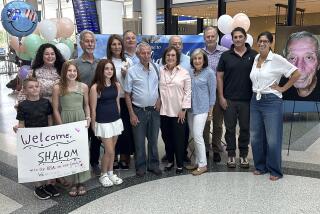In some cases, the dead can even overshadow the living, she said.
- Share via
A notice in the newspaper attracted a couple of dozen people Saturday to the basement of a hardware store on the Golden Mall in Burbank. There the history of the world is being written one family at a time.
Each person who arrived got a quick picture of what lay ahead.
People sat at long library tables poring over books. They thumbed through card catalogues. They browsed along the bookcase-covered walls. They whispered to each other about their progress and occasionally let their excitement escape out loud.
“Good afternoon. I bring you greetings from telephone directories, tombstones, musty old papers and many interesting places,” Barbara McKinlay, a volunteer for the Southern California Genealogical Society, told a group of newcomers who were assembled on metal chairs at one end of the room to learn what genealogy is all about.
McKinlay is a teacher of the society’s beginning genealogy class. She passed around some of the tools of genealogical research. There were an 1857 death certificate, a War of 1812 Company Muster Roll, the citizenship papers of a Yugoslavian housewife, a list of passengers who landed in Baltimore during the last month of 1837 and a 1755 land plat picturing the 400 acres belonging to Thomas Dillard of Halifax County. There was also a page from the 1900 census detailing the vital information of a dozen people.
They were all photocopies, of course. Still, each one seemed to shout about the ambitions, the achievements and the inevitable end of all the people they named. In some cases, the dead can even overshadow the living, she said.
“You will find yourself turning aside the letters from your children in order to get to the letter from your genealogical friend,” McKinlay said.
At the other end of the room, the main speaker was Jean Nepsund, a slight woman of 60 with olive skin and mostly black hair bunched primly in the back.
She said genealogists seem crazy to ordinary people.
“You will find they have a common characteristic,” she said. “They can go into a library and stick their heads into a microfiche machine eight hours and enjoy it. They can go into a courthouse and open a dusty book and, with tears running from their eyes, have fun.
“Once you get accustomed to genealogy, you find this is fun. This is just more fun than anything else we have ever done. If we can do it 16 hours a day, we will.” Although she was not a practiced speaker, Nepsund held the attention of her audience by telling a story that made her visibly excited: how she pieced together her family’s part in the history of America.
It was a convoluted tale with subplots that wandered with no apparent beginning or end from the Monongahela River to the town of Gross Bundenbach in West Germany.
But its beginning was distinct. It was in 1973, the year her mother died, three years after her father died.
“I wasn’t into genealogy then,” Nepsund said. “Just shortly after they died, I thought, ‘Oh, gee. Why didn’t I ask them anything?’ ” She was lucky. When she returned home to Ohio for her mother’s funeral, she found a box of memorabilia such as newspaper obituaries, a family record book and photographs. The search was on.
It led first to a small town in Germany where Nepsund and her husband stopped on their way to visit his ailing brother in Norway.
They were welcomed by Frau Stucky, a distant relative.
“They were just so delighted that we were there, they almost wouldn’t let us get away,” she said. “We didn’t know then how we were related. It turned out we were eighth cousins. We were related by a man who lived in 1649.” Back in the states, Nepsund ran into impediments. She showed an aunt a family photograph taken at her great-grandfather’s wedding anniversary, hoping to learn the names.
“Aunt Laura had just had a stroke and never spoke a word after that,” she said.
She started making trips to visit her sisters in Ohio and always slipped across the state line into Adams County, Ind., where her parents were born.
The county record book produced some tales of a Wendell Brown, who fought in the French and Indian War and was captured by Indians and finally died a pauper.
She was excited at the prospect that he was an ancestor. Because of genealogy’s motto, “There is no truth without proof,” she couldn’t claim him yet.
“Brown is such a common name,” she said.
The trail led on to Fayette County, Pa., where she found more strands of the story connecting Wendell Brown to a great-grandfather she knew was hers. That was the proof she needed.
She pursued the search and found the signature of Johan Wendel Braun, a German immigrant, on an affidavit swearing loyalty to King George I and the Protestant faith upon his landing in Baltimore in 1738.
Was it her Wendell Brown?
The answer came from the county clerk’s office in South Fork, Va., where her Wendell Brown had signed a petition to the town clergy protesting the habits of one David Evans, who “is so leasy that he will not Work to provide for his family.”
The signatures matched. It was her Wendell Brown.
The audience clapped.
As they left, several of them picked up applications to join the society.
It appeared that history was gaining a few more chroniclers.
More to Read
Sign up for Essential California
The most important California stories and recommendations in your inbox every morning.
You may occasionally receive promotional content from the Los Angeles Times.














